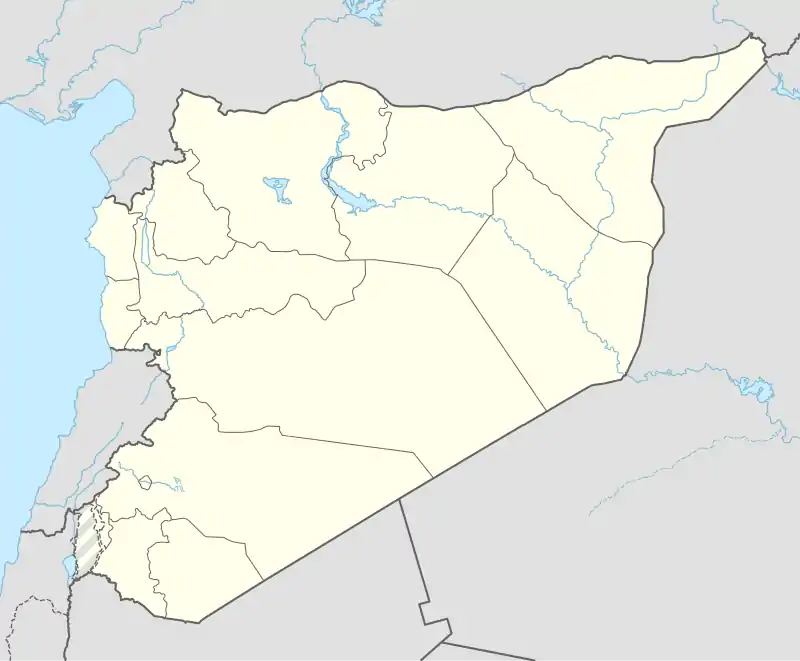Inkhil
Inkhil (Arabic: أنخل, romanized: Ankhil) is a town in southern Syria, administratively part of the al-Sanamayn District of the Daraa Governorate. It is located north of Daraa and just east of the Golan Heights in the Hauran plain. In the 2004 census by the Syria Central Bureau of Statistics it had a population 31,258.[1]
Inkhil
أنخل | |
|---|---|
 Inkhil | |
| Coordinates: 33°0′N 36°7′E | |
| Grid position | 256/269 |
| Country | |
| Governorate | Daraa |
| District | Al-Sanamayn |
| Subdistrict | Al-Sanamayn |
| Population (2004 census)[1] | |
| • Total | 31,258 |
| Time zone | UTC+2 (EET) |
| • Summer (DST) | UTC+3 (EEST) |
History
Among the ancient ruins found in Inkhil are the remains of a large villa dating from the 2nd century CE during Roman rule. Within the building is large vaulted central hall which connects to several rooms containing busts and other Roman-era sculptures carved from basalt. Its facade has highly decorated entrances and conch-head niches.[2] During Byzantine rule, Inkhil was dominated by the Ghassanids, Arab vassals of the empire based in nearby Jabiya.[3]
In 1596 Inkhil appeared in the Ottoman tax registers under the name of Nahal, being part of the nahiya of Bani Kilab in the Hauran. It had an entirely Muslim population consisting of 86 households and 45 bachelors. They paid a fixed tax-rate of 40% on agricultural products, including wheat, barley, summer crops, goats and bee-hives; in addition to occasional revenues; a total of 13,000 akçe. Most of the income (22 out of 24 parts) went to a waqf (religious trust).[4]
The town consisted of about 50 houses in the early 1840s all of which were inhabited by Muslims.[5] According to German archaeologist Gottlieb Schumacher, Inkhil was recorded to be a "small place numbering 55 to 60 huts" in 1897.[6]
Inkhil was one of the first towns to participate in the 2011-2012 Syrian uprising against the government of Bashar al-Assad in March 2011 following demonstrations in Daraa.[7] On 19 August four protesters were killed and dozens injured after Syrian security forces shot at demonstrators emerging from a mosque following Friday prayers.[8]
References
- General Census of Population and Housing 2004 Archived 2012-12-20 at Archive.today. Syria Central Bureau of Statistics (CBS). Daraa Governorate. (in Arabic)
- Ball, 2002, pp. 240-241.
- Shahid, 2002, p. 203
- Hütteroth and Abdulfattah, 1977, p. 211
- Newbold, 1846, p. 335
- Schumacher, 1897, p. 190
- Sterling, Joe. Daraa: The spark that lit the Syrian flame. CNN. 2012-03-01. Retrieved on 2012-03-21.
- Inkhil Live Blog. Al Jazeera English. 2011-08-19. Retrieved on 2012-03-21.
Bibliography
- Ball, Warwick (2002). Rome in the East. Routledge. ISBN 9780415243575.
- Hütteroth, Wolf-Dieter; Abdulfattah, Kamal (1977). Historical Geography of Palestine, Transjordan and Southern Syria in the Late 16th Century. Erlanger Geographische Arbeiten, Sonderband 5. Erlangen, Germany: Vorstand der Fränkischen Geographischen Gesellschaft. ISBN 3-920405-41-2.
- Newbold, Captain (1846). "On the site of Ashtaroth". The Journal of the Royal Geographical Society: JRGS. Murray. 16: 331–338. doi:10.2307/1798240. JSTOR 1798240.
- Schumacher, G. (1897). "Notes from Jedur". Quarterly Statement - Palestine Exploration Fund. 29: 190–195. doi:10.1179/peq.1897.29.3.190.
- Shahîd, I. (2002). Byzantium and the Arabs in the Sixth Century: pt. 1, Toponymy, Monuments, Historical Geography, and Frontier Studies. Dumbarton Oaks Research Library and Collection. ISBN 0884022145.
External links
- Map of town, Google Maps
- Sanameine, 19L map